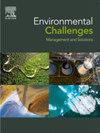Spatiotemporal dynamics and machine learning-based risk assessment of heavy metal contamination in surface waters and Nile Tilapia in Egypt
Q2 Environmental Science
引用次数: 0
Abstract
Heavy metals are persistent pollutants that can devastate human health and ecosystems. In this study, we collected surface water and fish samples from various locations across five governorates in Egypt. We examined the spatiotemporal distribution of 13 heavy metals in the surface water and Nile tilapia and assessed the ecological and human health risks associated with these metals. Moreover, we utilized statistical and machine learning approaches, including principal component analysis (PCA) and linear discriminant analysis (LDA), to explore the relationships between the metals themselves and between the metals and specific governorates or seasons. Our spatiotemporal analysis revealed that aluminum (Al) and iron (Fe) are more concentrated across all governorates every season than other metals. The ecological risk assessment indicates a higher risk for Al and a moderate risk for Fe. Our findings suggest that concentrations of Fe, Cd, Pb, Mn, Al, Ni, and Hg in surface water from aquaculture exceeded national and international standards, posing risks to aquatic ecosystems. In fish, Cd levels surpassed the thresholds set by global standards but remain below the Egyptian limits, indicating a need for ongoing monitoring. Furthermore, Mn concentrations significantly exceed the limits established by Egyptian regulations and the FAO, necessitating ongoing monitoring. The human health risk assessment reveals no health risks associated with dermal exposure to metals in surface water. However, there is a moderate carcinogenic risk associated with ingesting Nile tilapia due to the presence of cadmium, barium, nickel, and chromium. PCA and LDA results provide insights into the interactions among metals, allowing us to identify which metal is unique in a particular governorate as well as the potentials of co-occurrences of various metals, which opened avenues for a deeper investigation into potential sources of metal and the cumulative effects of clustered metals on human health and the consequences of simultaneous exposure. Collectively, our study highlighted the foreseeable risk of heavy metals to human health and advocated for examining potential sources of pollution, implementing monitoring programs, imposing strict regulations, applying safety interventions, conducting public awareness campaigns, and screening programs to reduce the hazardous effects on human health and the environmental system.

埃及地表水和尼罗罗非鱼重金属污染时空动态及基于机器学习的风险评估
重金属是可以破坏人类健康和生态系统的持久性污染物。在这项研究中,我们从埃及五个省的不同地点收集了地表水和鱼类样本。我们研究了13种重金属在地表水和尼罗罗非鱼中的时空分布,并评估了与这些金属相关的生态和人类健康风险。此外,我们利用统计和机器学习方法,包括主成分分析(PCA)和线性判别分析(LDA),来探索金属本身之间以及金属与特定省份或季节之间的关系。我们的时空分析显示,铝(Al)和铁(Fe)在所有省份的每个季节都比其他金属更集中。生态风险评价结果显示,Al的生态风险较高,Fe的生态风险中等。我们的研究结果表明,水产养殖地表水中Fe、Cd、Pb、Mn、Al、Ni和Hg的浓度超过了国家和国际标准,对水生生态系统构成了威胁。在鱼类中,镉含量超过了全球标准设定的阈值,但仍低于埃及的限值,表明需要进行持续监测。此外,锰浓度大大超过埃及法规和粮农组织规定的限值,需要进行持续监测。人体健康风险评估显示,皮肤接触地表水中的金属不会带来健康风险。然而,由于含有镉、钡、镍和铬,摄入尼罗罗非鱼有中度致癌风险。PCA和LDA的结果提供了对金属之间相互作用的见解,使我们能够确定哪种金属在特定省份是独特的,以及各种金属共同出现的可能性,这为深入调查金属的潜在来源和聚集金属对人类健康的累积影响以及同时接触的后果开辟了途径。总的来说,我们的研究强调了重金属对人类健康的可预见的风险,并提倡检查潜在的污染源,实施监测计划,实施严格的法规,应用安全干预措施,开展公众意识运动,以及筛选计划,以减少对人类健康和环境系统的有害影响。
本文章由计算机程序翻译,如有差异,请以英文原文为准。
求助全文
约1分钟内获得全文
求助全文
来源期刊

Environmental Challenges
Environmental Science-Environmental Engineering
CiteScore
8.00
自引率
0.00%
发文量
249
审稿时长
8 weeks
 求助内容:
求助内容: 应助结果提醒方式:
应助结果提醒方式:


